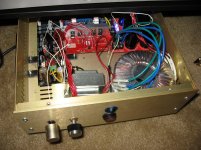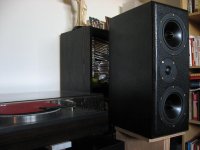Next step is 600mA per side then 2A, for enough perceivable niceness. But 200-250mA is the main chunk. Then up it goes diminishing returns. 
P.S. Post in 1024x748 links from now on (don't forget to kill the .th in the link else its thumbnails), the server takes refresh to auto resize, and big photos hinder browsing for people on laptops. I am gonna fix the above pics.

P.S. Post in 1024x748 links from now on (don't forget to kill the .th in the link else its thumbnails), the server takes refresh to auto resize, and big photos hinder browsing for people on laptops. I am gonna fix the above pics.
You mean the reg's Vout? You can touch the 3rd pin of the Mosfet nearer to the relay with one probe, the other probe earthed.
Yes, thanks Salas!
So would any other changes be required to try 600mA aside from larger sinks?
From my experiment, the most noticeable improvement was from 60ma to around 120ma. After that, the only thing that I could feel going up was the temp. So, I settled on 140ma. I also found keeping the FETS too cold didn't sound as good as keeping them at 40C and upward. Mine are at 45C inside the (old external SCSI HD) case.
Yes, thanks Salas!
So would any other changes be required to try 600mA aside from larger sinks?
I would place bigger resistors. Imagine you are using 10ohm resistors. That's about 250ma, so 0,625w aprox. We use 5w resistors for long term accuracy.
If you use 500ma with a 5ohm resistor, that's about 1.25W. So I will use something bigger than 5w if possible.
I would place bigger resistors. Imagine you are using 10ohm resistors. That's about 250ma, so 0,625w aprox. We use 5w resistors for long term accuracy.
If you use 500ma with a 5ohm resistor, that's about 1.25W. So I will use something bigger than 5w if possible.
Thanks Reg. I'll stick w/ the 10 ohm then. Doesn't sound like there would be much to gain from going lower.
Just want to add some resistor comparison info:
I have all PRPs (and Dale for 220k) in my Mezmerize outputs. The board had about 25-30 hours burn-in. The sound was clean, clean, clean. Very wide soundstage, precise imaging. Very low noise. But it was a little too metallic for my taste, especially in upper treble. This would probably tame after 100 hours but I thought why not do a resistor change and compare. Usually when I change resistors I am also changing another component, so this was a chance to get direct comparison.
I replaced the PRPs with 220R Shinkoh and Takman carbon for 220k. Right away the difference was clear! The Shinkoh is not as clean, the soundstage is wide but not as much as PRP. However, the shinkoh is immediately engaging and very, very musical and a little warm. There is good detail, just not as much as the PRP, because the PRP is so quiet.
I will let everything burn in now for the 100+ hours and see how I feel.
Both resistors sound incredible, just depends on your taste. Ultimately I may mix the PRP w/ shinkoh, because the PRPs just sound so clean and clear. I know that ideally I should have let the PRP stay for full burn-in. I may try that later...
Here is my build: Integrated amp of Mez board w/ Classdaudio CDA-254 amp.
I have all PRPs (and Dale for 220k) in my Mezmerize outputs. The board had about 25-30 hours burn-in. The sound was clean, clean, clean. Very wide soundstage, precise imaging. Very low noise. But it was a little too metallic for my taste, especially in upper treble. This would probably tame after 100 hours but I thought why not do a resistor change and compare. Usually when I change resistors I am also changing another component, so this was a chance to get direct comparison.
I replaced the PRPs with 220R Shinkoh and Takman carbon for 220k. Right away the difference was clear! The Shinkoh is not as clean, the soundstage is wide but not as much as PRP. However, the shinkoh is immediately engaging and very, very musical and a little warm. There is good detail, just not as much as the PRP, because the PRP is so quiet.
I will let everything burn in now for the 100+ hours and see how I feel.
Both resistors sound incredible, just depends on your taste. Ultimately I may mix the PRP w/ shinkoh, because the PRPs just sound so clean and clear. I know that ideally I should have let the PRP stay for full burn-in. I may try that later...
Here is my build: Integrated amp of Mez board w/ Classdaudio CDA-254 amp.
Attachments
Last edited:
No buzz with so big transformer in there? What are those brownish film caps? Orange drops like? Mind you those have a say on the final tone. But let it settle for more play hours as you say. Congratulations for having it working as an integrated on first go.
P.S. Its the Class D amp's tone mixing we must not forget, so its a system thing the parts preferences. What kind of speakers in use utilizing 250W per channel?
P.S. Its the Class D amp's tone mixing we must not forget, so its a system thing the parts preferences. What kind of speakers in use utilizing 250W per channel?
No buzz with so big transformer in there? What are those brownish film caps? Orange drops like? Mind you those have a say on the final tone. But let it settle for more play hours as you say. Congratulations for having it working as an integrated on first go.
P.S. Its the Class D amp's tone mixing we must not forget, so its a system thing the part's preferences. What kind of speakers in use utilizing 250W per channel?
Btw, the wiring has been cleaned up. That pic was from my 'test' run.
No buzz at all, although I wonder if getting a steel cover for the toroid would be of benefit?
The film caps are PPS .1uf. I am unsure of what they may add to the sound, I just read they were good and were available from digikey with my other purchases. Hm, I guess I will have to try some other caps then to see what difference can be made...
Yes, my opinions are based on total synergy w/ the classdaudio amp and others will have different impressions. It is a very smooth amp, very transparent, very dynamic.
My speakers are 4 ohm DIY MTM w/ Dayton RS180 woofers and Seas 27TDFC tweeters. XO designed by Jay Kim. 250w is more than I need but it was only $15 more than the 120w version, so hey why not!
Attachments
Last edited:
Its good having spare power. Such MTM speakers (4 Ohm also?) can be current sinks when under 90dB 1W/m. 3dB for a higher recorded peak is nothing to the ear but its double power. Especially with vinyl records over 0dB is common in enough. PPS is a great and not much appreciated dielectric IMHO. You can compare some but those you have may prove no slouches. Currents, offsets, voltages all OK I suppose?
No don't cover the Tx if there is no buzz. Let it breathe.
No don't cover the Tx if there is no buzz. Let it breathe.
Wushilui,
I think the carbon films certainly add a lot of tone to the DCB1, for some this will be a good thing. When I removed Carbon films from mine, I noticed a lot of improvement.
treble grain sounds like a cap issue IMO.
I would let the whole thing remain on for about 5 days and check again. I think burn in is important in this design.
The 220R position is also most critical to signal change.
I think the carbon films certainly add a lot of tone to the DCB1, for some this will be a good thing. When I removed Carbon films from mine, I noticed a lot of improvement.
treble grain sounds like a cap issue IMO.
I would let the whole thing remain on for about 5 days and check again. I think burn in is important in this design.
The 220R position is also most critical to signal change.
AFAIK, it hasn't been tried yet (higher current than 205mA) in this design.Thanks Reg. I'll stick w/ the 10 ohm then. Doesn't sound like there would be much to gain from going lower.
Looking at your picture, I can see a radioshack transformer. This has been VERY bad reported by other builders of this boards. The say that it runs very hot and buzzes.
I like your case, BTW
Regards,
Regi
Currents, offsets, voltages all OK I suppose?
Offset is good: .6mV/2mV
Voltage: I got a reading of 10.78v from the third pin of mosfet closest to the relays.
How do I check the current?
Last edited:
Wushilui,
I think the carbon films certainly add a lot of tone to the DCB1, for some this will be a good thing. When I removed Carbon films from mine, I noticed a lot of improvement.
treble grain sounds like a cap issue IMO.
I would let the whole thing remain on for about 5 days and check again. I think burn in is important in this design.
The 220R position is also most critical to signal change.
Yeah, I will have to decide what kind of sound I prefer. Choices, choices!
Win-win either way...
Also, the Shinkoh are tantalum resistors...
Last edited:
AFAIK, it hasn't been tried yet (higher current than 205mA) in this design.
Looking at your picture, I can see a radioshack transformer. This has been VERY bad reported by other builders of this boards. The say that it runs very hot and buzzes.
I like your case, BTW
Regards,
Regi
I read about the RS issues, but I hear zero buzz and it doesn't run hot at all... and I've used 2 of them.
Those Mosfets still amaze me with their ruggedness. So tiny sinks and they survived. Didn't I tell to use proper sinks or bolt to thick floor so many times? You can't run on same sinks you use for regular setting a hot rod. OK, killing a Mosfet is no big deal, but if someone uses a DC amp without output relay DC sense, bye bye speakers.
I also found keeping the FETS too cold didn't sound as good as keeping them at 40C and upward. Mine are at 45C inside the (old external SCSI HD) case.
Salas,
which temperature is safe for the mosfets?
After using 2cm spacers mines are at 53°C and before the case is ready another month will pass...
Is it better to disconnect it until case is ready?
Thanks in advance
- Home
- Amplifiers
- Pass Labs
- Building a symmetrical PSU B1 buffer

